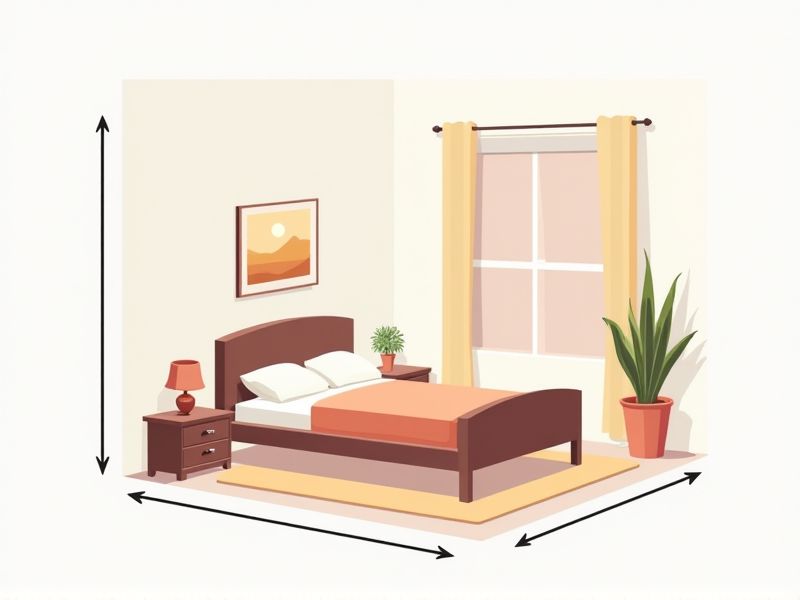
When planning a bedroom, knowing standard dimensions can help you optimize space and comfort. Typically, a small single bedroom measures around 8 feet by 10 feet (2.4m x 3m), which works well for a twin bed and basic furniture. For a more comfortable standard bedroom, common dimensions are about 10 feet by 12 feet (3m x 3.6m), allowing space for a queen bed, dressers, and some walking room. Master bedrooms usually start at 12 feet by 14 feet (3.6m x 4.3m), giving you ample room for larger furniture and additional amenities like seating areas or a desk.
Bed Size
A standard queen bed measures 60 inches wide by 80 inches long, providing ample sleeping space for couples or individuals who prefer more room to stretch out. In contrast, a king bed, which is 76 inches wide and 80 inches long, offers even more space, ideal for those who prioritize comfort and have sufficient room in their bedroom. Twin beds, measuring 38 inches wide and 75 inches long, are commonly used in children's rooms or smaller guest areas. Consider the dimensions of your bedroom when selecting a bed size, as it significantly impacts your overall comfort and movement within the space.
Room Circulation
Room circulation in a bedroom is essential for promoting comfort and accessibility. Ideally, a minimum of 24 inches of clear pathways around the bed allows free movement, significantly reducing clutter. Consider the layout by placing furniture, such as dressers and nightstands, to facilitate efficient flow while ensuring easy access to wardrobes and other storage options. Optimizing these spatial arrangements can enhance your bedroom experience, maximizing both functionality and aesthetics.
Storage Space
A well-designed bedroom typically incorporates an average of 10-15% of its total area for storage space to enhance functionality and organization. Utilizing built-in wardrobes and under-bed storage solutions can significantly increase capacity, providing up to 50% more storage compared to traditional solutions. On average, optimizing vertical space with shelves can free up to 30% of floor space, offering a clutter-free environment. When selecting furniture, consider multi-functional pieces such as storage ottomans or nightstands with drawers to maximize storage efficiency while maintaining aesthetic appeal.
Window Placement
Proper window placement in a bedroom significantly enhances natural light and ventilation, which are crucial for a comfortable living space. Ideally, windows should be positioned to face the east or west, allowing for optimal morning and afternoon sunlight exposure. A standard recommendation is to have at least 10% of the total wall area dedicated to windows, which effectively balances light and privacy. When planning your bedroom layout, consider the window size and height to ensure they complement your furniture arrangement and maintain an inviting atmosphere.
Door Clearance
A well-designed bedroom should prioritize door clearance, typically requiring a minimum of 32 inches for accessibility. This space ensures that the door opens fully without obstruction, allowing ease of movement for you and your guests. In smaller bedrooms, consider using sliding or pocket doors, which can save valuable floor space. Maintaining an unobstructed area of at least 36 inches in front of the door enhances functionality and promotes a more welcoming environment.
Ceiling Height
The recommended ceiling height for a bedroom is typically between 8 to 10 feet to ensure adequate airflow and a sense of spaciousness. A higher ceiling can enhance natural light, making the room feel more inviting and comfortable. For optimal sound insulation, consider adding acoustic panels or textured finishes, especially if you live in a noisy environment. Your bedroom's ceiling height can significantly impact both aesthetic appeal and overall functionality, creating a serene retreat for rest.
Furniture Layout
An optimized bedroom furniture layout typically involves strategically placing a queen or king-size bed against the room's focal wall, allowing for optimal space utilization and flow. Nightstands should be positioned on either side of the bed for convenience, providing easy access to essentials while enhancing symmetry. A dresser can be placed along the opposite wall, ensuring ample storage without overwhelming the room's dimensions. Incorporating a comfortable chair in a corner can enhance usability, offering a cozy spot for reading or relaxation while keeping pathways clear.
Electrical Outlets
A standard bedroom typically features at least two electrical outlets on each wall, allowing for convenient access to power devices like lamps, chargers, and electronics. The National Electrical Code recommends that outlets be installed no more than 12 feet apart to minimize the need for extension cords, ensuring safety and ease of use. For your comfort, consider positioning outlets near the bedside to conveniently charge your devices overnight. If your bedroom design includes furniture placements, ensure that outlets are not obstructed by larger pieces, maintaining full functionality.
Lighting Design
Effective bedroom lighting design incorporates a combination of ambient, task, and accent lighting to create a harmonious environment. Ambient lighting, such as ceiling fixtures or recessed lights, should provide adequate illumination, typically around 150-300 lux, to ensure comfort. Task lighting, like reading lamps or bedside sconces, can offer focused light for activities, ideally featuring adjustable brightness and color temperature settings between 2700K and 3000K for a warm atmosphere. Incorporating dimmers allows you to customize light levels, enhancing both functionality and mood in your personal space.
Ventilation Options
Ventilation options in a bedroom significantly impact air quality and comfort, promoting a healthier living environment. Natural ventilation can be achieved through operable windows, allowing fresh air to circulate; studies show that rooms with adequate airflow can reduce indoor air pollutants by up to 50%. Mechanical ventilation systems, such as exhaust fans and heat recovery ventilators, can improve energy efficiency while ensuring a consistent supply of fresh air, which is particularly crucial in areas with high humidity or pollutants. By implementing proper ventilation strategies, you can enhance sleep quality, reduce allergens, and create an overall more pleasant atmosphere in your bedroom.
